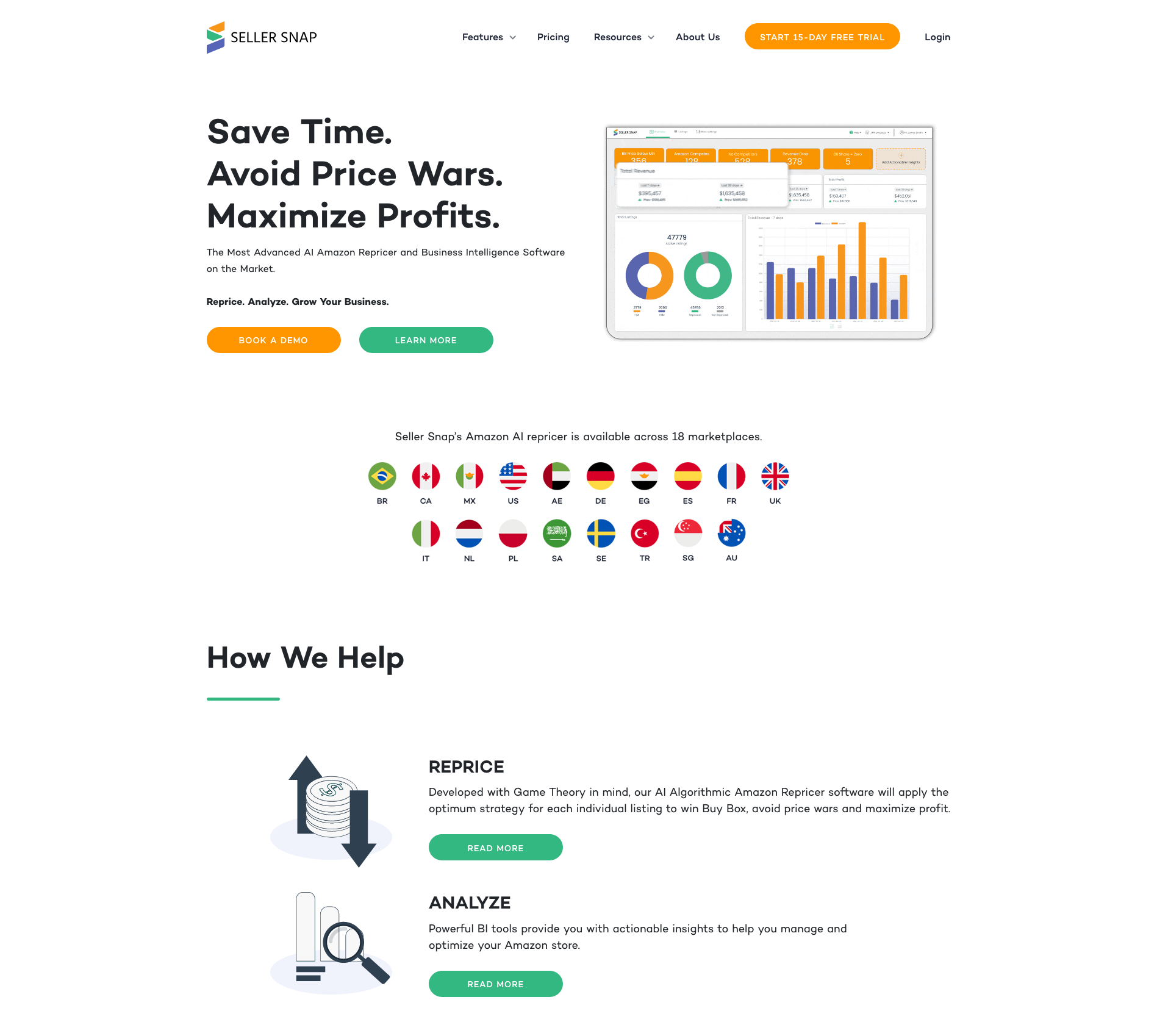Real-World Amazon Pricing Strategies for 2022 (With Examples)

As Amazon sellers, we're always pushing to increases product sales. And the same time, our strongest competitors have an Amazon pricing strategy that's well-tuned yet dynamic, allowing them to stay competitive in the ever-changing marketplace.
Creating a realistic pricing strategy should be your priority in 2022 and requires fine-tuning. Aiming too high may see your customers seeking out your competitors while pricing too low might start the notorious race to the bottom on pricing.
Let's make that process of pricing your product easier.
We'll be showcasing a dozen real-world ideas to help you stay balanced on the tightrope between holding strong product margins while increasing your sales volume month-on-month.
Initial Considerations
Before we begin, there are 3 things to consider before you make massive changes to your product price and value offering.
Assess Your Cost-Base
Consider not just how much you've paid and are yet to pay for your product (including FBA fees), but the time-cost associated with waiting for production and shipping. Maintaining a healthy profit margin should be prioritized over choosing the right price for your product. You'll also need to account for product returns.
Analyze Your Highest and Lowest Possible Price
By knowing your upper and lower limits, you're able to keep your product competitive with other sellers. Your minimum price should be break-even (unless you have a profitable upsell) while your maximum should only be slightly above your highest competitor.
Understand Your Target Market
Amazon is notorious for attracting price-sensitive consumers, but just about everyone is seeking a good deal nowadays. By understanding the end consumer before making changes, you're able to avoid a consumer feeling let down if you increase the price, or vice-versa, let down if you decrease the price after they purchased your product.
Tangible Amazon Pricing Strategies
Now, let's look at how you can hit the mark with real-world terms.
Here is how to create an effective Amazon pricing strategy in 2022:
1. Track Your Competitors Daily
For those sellers who have a large range of products, it can be difficult to track and price manually. You didn't become an Amazon seller merely watch listings all day long.
Tools like RepreiceIt and RepricerExpress will allow you to see your competitor's existing pricing strategy and historic trends, much like a share trading graph. You can add upper and lower limits so you avoid selling for below costs, plus create many other setpoints.
2. Split-Test Your Pricing Annually
An A/B split-test is an excellent way to compare two prices you may have in mind but eventually takes the emotion out of the picture. You'll have real-world data to make firm decisions based on the sales volumes. Amazon has its own tool:
You may be selling a vegan wallet at $27.99 but see some competitors in the $30 to $40 range, but aren't sure if yours will sell well at a higher price point. Aim for a 30-day window to test your product at $35 and another at $27.99, preferably in an off-peak sales season to avoid anomalies.
3. Add Genuine Value To Your Products
Amazon is famously known for being customer-obsessed, and as a seller, you should be too. By providing more value to your customer in terms of product quality or bonus extras, you're more likely to see conversions.
In this example, this brand includes tackle boxes with their fishing bag, saving the customer from having to purchase these separately:
Some additional examples include a recommended cleaning agent for your product, a storage bag or case, or simply adding some batteries that the customer would otherwise have to buy separately. This can add huge loyalty and increase the likelihood of a 5-star review.
4. Consider Automated Repricing Software
There are several excellent options on the market to reprice your products automatically based on competitors' pricing, your inventory volume and trends. This is most popular with textbook sellers who price aggressively during January and August.
Generally speaking, you can go without repricing software if you're a private seller with less than 20 items. They're best for retailers competing for the Buy Box and will help in minimizing error margins and provide instant price checks without the constant attention.
Bindwise can monitor your listing and will instantly alert you if you lose the Buy Box. We have also included some highly regarded FBA pricing tools below.
5. Be Mindful Of The Pricing Algorithm
Amazon is constantly improving its pricing algorithm, and pricing does play a role in organic rankings based on regular price changes. Buyers aren't likely to purchase your highly overpriced product on the 17th page of Amazon's SERPs.
Amazon sees that price stability builds customer loyalty within some product lines such as gaming consoles, while other lines such as books require regular pricing changes. Essentially, both price stability and volatility can improve or hurt your rankings, but this depends on your individual product.
If you're unsure, simply use a repricing tool on your competitor's products and observe their trends over time.
6. Adjust Your Pricing Based On Seasonality and Trends
Q4 is commonly known as the best time to raise prices. Apologizes for the pun, but this is prime time to be proactive with your pricing strategy. As your competitors gradually run out of stock, your price can gradually increase on a near-daily basis.
Likewise, there are seasons where you may need to make adjustments. If you're selling a pickleball set, prepare to raise your prices around April and decrease them again around August to take advantage of the summer sales season.
7. Always Price Above Your Lowest Competitor
Don't make the mistake of pricing your product too low. Your lowest competitor often has the cheapest product for a reason - it's cheap. And if you've been around for long enough, you'll no that cheap products just aren't as profitable in 2022.
You'll not only appear cheap to potential customers but could cause harm when you do increase prices. These include the bottom-rung of customers that may have been holding out until their next payday. Even if you're launching, be the 2nd or 3rd cheapest product in your category and at least 2% more than the lowest seller.
8. Avoid Reactive Price Wars
If you've been around FBA for any amount of time, you would have undoubtedly heard of the race-to-the-bottom with pricing wars. This is typically the domain of cutthroat Chinese sellers running on thin margins.
However, US-based sellers sometimes go into competition with their counterparts. Avoid knee-jerk reactions and instead use tools such as CamelCamelCamel to check trends. Repricing software can (by default) sometimes be too reactive when a competitor alters their price.
9. Price Above Amazon's Free Shipping Minimum
Amazon has almost 150 million Prime users who qualify for free shipping on many products, but what about the non-Prime members? They pay for shipping on orders below $25.
In this simplified example, the flag on the left is priced higher with free shipping than compared to the flag on the right:
As this could add up to $10 to a customer order on checkout, it may deter a purchase. If you could sneak just above that $25 threshold, it's likely you'll score a higher conversion rate with your non-prime customers though you may now deter some Prime customers.
10. Never Let Your Pricing Become Stale
Ignoring your price for months on end is one way to go obsolete. Sure - many established big-name brands do this all the time, though they have existing data, cash flow from other products and many more sales channels to handle an oversight.
You should be checking upon your competitors at least once per month, or ideally weekly. Pay attention to not only their price, but coupons, bonuses and upsells they offer their customers. Also consider that each unique product needs its own unique pricing strategy, especially if it appeals to a different audience.
11. Raise Your Prices And Use Coupons
Coupons are one of the best ways for a new seller to gain traction on their listing. Not only that, but can increase conversions and loyalty on established listings.
In this example, a buyer gets $10 off by simply pressing a button:
A sneaky yet successful practice that has almost become industry-standard is raising your prices then creating 5% to 10% off coupons. Your customer will psychologically feel as though they're getting a great deal.
Careful with this as customers can be put off should you discount too heavily.
12. Use Special Discounts Around Industry Events
Outside of Black Friday, Cyber Monday and Q4, here are numerous industry events throughout the year which you can harness to offer coupons and discounts.
Take for example the vegan wallet mentioned above. You could offer a discount or 2 for 1 deal on World Vegan Day or during Texas Go Vegan Week. Likewise, you could offer discounts on tennis equipment during World Cup Tournaments.
Types Of Pricing on Amazon
You may not realize it, but there are 4 main ways to price when it comes to selling on Amazon, or any other eCommerce platform for that matter.
You may find one of these strategies best fits your product type.
Economy
This is for mass-market products that have minimal shipping costs and serve a customer's everyday need, such as shampoo. Here the product will rarely have sales given how tight the margins already are.
This is best for both Chinese sellers and new sellers just getting started.
Premium
Being the opposite of economy pricing, a brand will price higher while being reliant on its brand name and product quality, but will routinely offer discounts on its high-end products. You'll find this with luxury brands such as Kate Spade, Lacoste and Tissot.
This is best for established brands and Shopify stores.
Skimming
Skimming is a powerful strategy where you price optimistically high while having very few competitors. This is best if you anticipate more competition on the horizon with your unique product. You'll be maximizing profits in the short term until your competition launches a similar product to the marketplace.
This is best suited for private label sellers creating a unique product.
Penetration
Sometimes known as a loss-leader, the penetration strategy sees you launch with the lowest possible price will most likely see you be unprofitable in the short term. The objective is to gain interest, establish market share, offer upsells, score the Buy Box, and later raise prices for long-term sustainability.
This is best for established sellers with access to capital and can handle the risk.
5 Best Amazon Pricing Software Solutions
We have hinted at several tools in this article to best help you manage your product pricing. For the serious seller with 20+ SKUs, consider these options:
RepricerExpress
RepricerExpress is one of the most popular tools around. It's perfect for retailers, liquidators, dropshippers, private label sellers and even those doing liquidation lots. For beginners, this is my #1 recommendation.

Why we like it: Works for both Amazon and eBay and is highly regarded by professional Amazon sellers.
BQool
For sellers across multiple marketplaces, BQool is a strong contender while the price is very reasonable, beginning at just $25/month.

Why we like it: Allows you to use an AI-powered Amazon repricer without paying hundreds each month.
Seller Snap
Seller Snap is designed for the top 2% of Amazon sellers with very advanced analytics to help you make data-driven decisions. Be warned though, this is the most expensive software on this list...and for good reasons.

Why we like it: Uses game theory tactics while avoiding pricing wars with other sellers, paired with the most advanced dashboard we've seen yet.
Aura
Aura provides rapid repricing and a lot of functionality without the cost, paired with a very helpful customer service team.

Why we like it: No additional cost for a ton of features others charge for.
Feedvisor
Feedvisor uses algorithmic repricing and machine learning to help you in real-time to not only claim, but keep that Buy Box as yours.

Why we like it: Uses an advanced algorithm to estimate the ideal price which leaves human emotion on the sidelines.
FAQs
Unlike other pricing guides, we've kept ours as straightforward as possible.
Here are some common questions from new Amazon sellers:
What Are The Risks Of A Bad Pricing Strategy?
By choosing the wrong price to set your product, you'll either overvalue or devalue your product causing reputational damage and customers will look elsewhere. Additionally, you might run out of inventory far quicker than expected, or on the opposite end, incur long-term storage fees.
How Can I Easily Price My Amazon Product?
For beginners, the easiest ways to price your Amazon products are by looking at your closest competitors and pricing in the middle of their highest and lowest range. From here, gradually decrease the price to gain more sales or increase to maintain higher profit margins.
Who Sets The Prices on Amazon?
In most cases, individual sellers will set their own price on Amazon. Some may be bound by contractual agreements from suppliers or distributors and must price at or near a recommended retail price. It's only through a Sold by Amazon listing or via Amazon Vendor Central where Amazon can directly control a product pricing.
Can I Be Penalized For Setting My Prices Too High?
Yes. Under the Amazon Marketplace Fair Pricing Policy, you can be suspended if you price excessively high. This doesn't necessarily mean you'll be suspended for merely 30% above your main competitors (unless an RRP is established), but more like 500% above for products that are near-identical. Sellers can also be suspended for price-gauging.
Does Amazon Give The Buy Box To The Cheapest Vendor?
Sometimes. The Buy Box is allocated to a vendor based on an algorithm, not a price. While it definitely takes into account product pricing, it also has to factor for sales history, seller feedback, buyer location, stock levels and more.
Final Thoughts
Aim to put your pricing strategy together today. Amazon is only becoming more competitive and simply being a passenger may work for your competitors, but you may struggle to get you the sales velocity you're seeking.
Don't simply follow the "drop prices to get sales" mantra often paraded within Facebook groups. As we've noted throughout this article, there is a lot more you could be doing right now.
Remain diligent with your price testing and you'll eventually find that sweet spot that generates both consistent sales and healthy profits.
Bindwise can also monitor your listings 24/7 for listing defects, Buy Box wins and much more. Start your free trial today.




